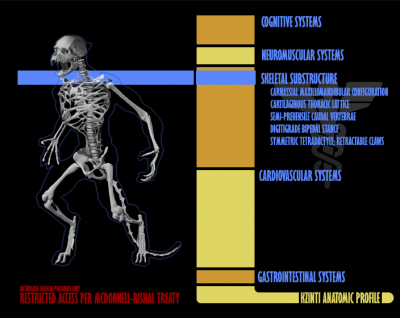Kzinti
From Star Trek: Theurgy Wiki
UNDER CONSTRUCTION
Physiology
On average, kzinti stand much taller than humans with a large male standing as much as eight feet (or 2.4 meters) in height and weight nearly 500 pounds (or 226 kg) with females being slightly shorter and less massive. The Kzinti homeworld has a gravity approximately 1.2 times that of the Earth which contributes greatly to their size and strength. In addition, their homeworld is, on average, 10 degrees colder than Earth, resulting in the additional genetic changes below.
Kzin are bipeds, standing erect on short, digitigrade legs. Kzin are typically covered in dusky brown or tan fur with individualized black markings not unlike that of a terran tiger most commonly appearing on the face and hands. This coloration allowed their ancestors to blend into the more mountainous regions and cave systems of their world to avoid dedication by prey. Specimens with full black fur are rare and all who have them are taken by the Black Priests. They are powerfully built, with thick limbs and torso and, although mammalian, they do not have a mammal-like rib cage, instead possessing a latticework of cartilaginous and bone struts encasing their torso. They have long, semi-prehensile tails and possess tetradactyl hands ending in three thick fingers and an opposable thumb, all possessing fully retractable claws, while their feet have three toes, also with retractable claws, and a dewclaw.
Kzinti possess a tri-cardial blood system, consisting of two semi-independent and redundant circulatory systems and a third, transitory proto-heart that controls pressure between the two systems, allowing blood to transition between them as necessary. As a result, a kzin could suffer cardiac arrest in any one of the hearts only for it to be restarted by the remaining two while blood flow remains relatively unaffected, perhaps causing only a slight light-headed sensation or transitory vertigo. Further, blood born pathogens and contaminants, including injections, are much slower to affect a kzin, often taking up to five or six times that standard time frame to take full affect unless both circulatory systems are affected (or injected) simultaneously.
All kzinti possess a region analogous to a cat's "scruff" situated from the base of their neck down between their shoulder blades. Stimulating this region, through massage, kneading or gentle gripping pressure can cause involuntary weakness, pacification and even receptiveness in a kzin. This is a conditioned response, theorized to be a hold over from ancient evolution, and many kzinti keep this area covered; although the triggered response is not strong enough to off-set actual aggression, hostility or other such visceral emotions.
Kzinti are exclusively carnivorous to the point that they are incapable of readily digesting plant matter primarily due to a lack of the necessary enzymes in their digestive track to break down the cellulose structure. They are known to regularly hunt even sentient species and to regularly consume the spoils of these hunts although these are "officially" declared as punishments for crimes against the Patriarchy.
Senses
The head is quite cat-like in appearance, although with a large cranial bulge. Their eye colors vary from yellow to near-red, with round pupils instead of cat-like vertical slits. They do, however, possess a tapetum lucidum, which is a reflective layer behind the retina that sends light that passes through the retina back into the eye. While this improves the ability to see in darkness, it appears to reduce net visual acuity, thus detracting when light is abundant. This gives the kzin a minimum light detection threshold up to seven times lower than that of humans and also has the effect of causing a kzin's eyes to glow slightly in response to light sources. Kzinti eyes have a visual range between 200 and 850nm allowing them to see into the ultraviolet and infrared spectra unassisted.
Kzinti ears are structurally similar to fans and parasols, allowing them to fold tightly against the skull to the point of closing. Humans and kzinti have a similar range of hearing on the low end of the scale, but kzinti can hear much higher-pitched sounds, up to 64 kHz, which is 1.6 octaves above the range of a human, and even 1 octave above the range of a dog.
A kzin's sense of smell is about four times as strong as humans' as a result of the kzinti olfactory epithelium possessing almost twice as many receptors. As a result, the average kzin has a more acute sense of smell than humans. Unlike terran cats, however, kzinti do not possess vomeronasal (or Jacobson's) organ. Further, kzinti typically lack the ability to taste sweetness, which aids in their uncommon dietary nature as their modified sense of taste would cause them to some degree to ignore plants, a large part of whose taste appeal derives from their high sugar content, in favor of a high-protein carnivorous diet, which would still stimulate their remaining taste receptors.
Finally, kzinti possess, on average, twenty-four movable vibrissae ("whiskers"), in four sets on each upper lip on either side of its nose and in tufts over the eyes. The structure of the brain region (barrel cortex) which receives information from the vibrissae is similar to that found in the visual cortex which permits the cat to create a three-dimensional map of its surroundings. This doesn't mean that sensing with vibrissae is a type of vision. It is still a touch sensation and environmental information is built up incrementally (in small steps). Vibrissae aid sensation and navigation. The upper two rows of whiskers are able to be moved independently from the lower two rows for greater precision during measurement. These whiskers are more than twice as thick as ordinary hairs, and their roots are three times deeper. They have numerous nerve endings at their base, which give extraordinarily detailed information about nearby air movements and objects with which they make physical contact. They enable a kzin to know that it is near obstacles without it needing to see them.
Reproduction
Female kzinti, also referred to as kzinrett (pl. kzinretti) are only semi-intelligent, having long since been bred into sub-sapience by the Patriarchy, and are kept closely guarded in harems. Females typically do not speak and generally only understand a limited number of words and phrases, seldom exceeding a hundred. Those demonstrating higher intelligence, as tested by the Black Priests, are put to death at an early age by decree of the Patriarchy. Kzinti females are in heat only when fertile, and kzinti generally engage in sex solely for reproduction. Only kzinti males, or kzintosh (pl. kzintoshi), who have earned unique names through great deeds are permitted to acquire mates.
Psychology
Kzinti are, on average, slightly less intelligent than humans, although some members of the species are exceptions to that stereotype. Aggressive and territorial, kzinti have much more need of "elbow room" than do humans.
When time permits they frequently perform grooming, such as brushing their fur.
Language
The written script is based on claw-carvings in wood and is often described as 'dots and commas' by humans.
The language, itself, sounds clashing and terrible to human ears, but is in fact pitched and cased with several modes; mode being dependent upon who you are talking to. Although there is only one main language (the Heroes' Tongue), it has many modes including Mocking, Deferential, Technical and Royal, which is only spoken to and by royalty(the Patriarch and his kin). A human with plenty of spit and a good falsetto can learn the basic mode of the H. T. and be understood anywhere, but pronunciation will be difficult; similarly Kzinti can learn to speak Terran with some difficulty.
Kzinti count in octal, which means decimal-ten is represented a o12, d100 as o144 and so on.
Body language is, of course, very different from that of humans. A list of kzinti expressions and gestures follows:
| Emotion | Manifestation |
|---|---|
| Worry | A flattening of the fur |
| Frustration | Open-shut flare of nostrils, ticking noise from throat |
| Readiness | Ears laid flat |
| 'smile' | Twitching of ears |
| Slyness | Slight lidding of eyelids; could also mean calculating thought |
| Laughter | Twitching of ears and tail |
| Dismissive shrug | Yawn |
| Confusion | Careful sniffs of air, slight raise of muzzle |
| Threat | Bearing of teeth/fangs |
| Salute | Claw rake in front of own face. |
The tail is a great indicator of a kzin's mood. A lashing tail signifies worry. A dragging tail shows depression, a raised tail happiness. If the kzin's tail is hidden between it's legs, it is badly frightened. A slow, teasing motion of a kzinrret's tail-tip is considered extremely sexy by males, as is a cool, defiant stare.
The ears, too are highly expressive - a twitching indicates amusement, laid flat they indicate nervousness or readiness; and fanned out they indicate intent concentration or alertness. Sitting, standing or lying down with the legs splayed is considered obscene in both males and females.
Body language is also important in social encounters. Those of lower social status keep their eyes averted, except when challenging (and that in its correct place). Submission is signaled by covering of nose with paws, prostrating oneself or, in extreme circumstances, exposing belly and throat. A kzin who is about to attack or challenge will often adopt a threatening posture. The ears fold back to prevent them from being ripped or torn, the fur bottles out to hide the shape of the flesh, the tail becomes stiff and erect, ready to whip an opponents legs from under him. The lips pull back from the fangs in challenge, and the claws emerge ready for a fight. A kzin in this posture is about one second away from screaming and leaping - a favoured method of attack.
Kzinti also use scent a lot. They scent-mark with glands in cheeks and hands, occasionally using their urine. Their hormones are far more active than humans: a gingery smell signals excitement - either anger or fear.
See also: Lexicon
Home World
The Kzinti homeworld orbits the star 61 Ursae Majoris at a distance somewhat greater than that at which Earth orbits the sun. It is a larger world, with gravity 1.55 times that of Earth's. Its year is roughly one and a half times longer than Earth's, and its day is 27 hrs and 36 minutes long. The climate of this world is cooler and drier than Earth's, and since it has a definite axial tilt it also has seasons. It receives less light from it's star, which is redder than Sol; and is consequently dimmer.
The Kzinti refer to this world only as "Homeworld": it has no other name.
Culture & Customs
Kzin with high status have full names; those with low status have not earned a name, and are called by their profession. A moderate status earns a "partial name", for example "Chuft-Captain". Unlike Human aristocrats, even a Kzin born to a high-status family must earn his name. Kzinti refuse to perform menial work or practice animal husbandry. Therefore they must have slaves to perform these tasks, "or be barbarians roaming the forests for meat". A "conquest leader", leading the conquest of a planet, is entitled to one percent of its wealth for life.



